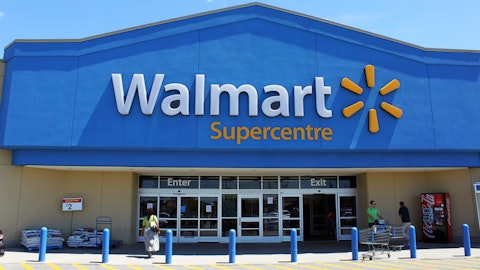Union Pacific Corporation (NYSE:UNP) Q4 2022 Earnings Call Transcript January 24, 2023
Operator: Greetings. Welcome to the Union Pacific Fourth Quarter 2022 Conference Call. At this time, all participants are in listen-only mode. A brief question-and-answer session will follow the formal presentation. As a reminder, this conference is being recorded and the slides for today’s presentation are available on Union Pacific’s website. It is now my pleasure to introduce your host, Mr. Lance Fritz, Chairman, President and CEO for Union Pacific. Mr. Fritz, you may now begin.
Lance Fritz: Thank you, Rob, and good morning. And welcome to Union Pacific’s fourth quarter earnings conference call. With me today in Omaha are Kenny Rocker, Executive Vice President of Marketing and Sales; Eric Gehringer, Executive Vice President of Operations; and Jennifer Hamann, our Chief Financial Officer. The fourth quarter and 2022 overall were challenging for Union Pacific and our employees. The lengthy labor negotiations tested our work force, while customers felt the impact of our service issues. Two things are critically important as we turn the page to 2023. First, is the trend line of improving free car velocity since late summer, although acknowledging there were bumps along the way. And second, is how we move forward, establishing consistent service for our customers day-in and day-out and demonstrating to all stakeholders our commitment to excellence.
Now turning to our fourth quarter results. This morning Union Pacific is reporting 2022 fourth quarter net income of $1.6 billion or $2.67 per share. This compares to fourth quarter 2021 results of $1.7 billion or $2.66 per share. Our fourth quarter operating ratio of 61% deteriorated 360 basis points versus 2021, driven by continued service challenges and the impact from winter weather. For the full year, reported operating ratio finished at 60.1%, deteriorating 290 basis points, driven by operational inefficiency, inflation and higher fuel prices. The entire Union Pacific team recognizes that 2022 did not beat expectations. Crew constraints in critical locations impacted by shifting demand had a real impact on our performance. As you will hear from Eric, we are building resiliency into the network through hiring efforts, shifting critical resources and better operations to address that shortfall, and you are seeing those benefits manifested in how the network has responded since Thanksgiving through the ups and downs of extreme winter weather.
These challenges aside, we achieved volume growth for the year. We demonstrated our commitment to meet customer needs with business development wins that are critical to long-term financial success. The recent onboarding of Schneider is a great proof statement of delivering on that commitment. We also made significant progress towards our climate goals. In 2022, we increased our biofuel blend to over 4.5% on pace to achieve our 2030 target of 20%. This is a key initiative in achieving our 2030 greenhouse gas emission reduction targets. In addition, for a fourth consecutive year, we improved our fuel consumption rate on a year-over-year basis, lowering at 1% to an all-time record. This helped our customers avoid 23.4 million metric tons of greenhouse gas emissions by using rail versus truck.
Union Pacific will continue to be a rail leader in sustainability. Now let’s start with Kenny for an update on the business environment.
Kenny Rocker: Thank you, Lance, and good morning. Fourth quarter volume was up 1% compared to 2021. Gains in our Premium Business Group were partially offset by a decline in our Bulk area. However, freight revenue was up 9%, driven by higher fuel surcharges and strong price. Let’s take a closer look at each of these business groups. Starting with Bulk. Revenue for the quarter was up 7% compared to 2021, driven by a 10% increase in average revenue per car, reflecting higher fuel surcharges and solid core pricing gains. Volume was down 3% year-over-year. Grain and grain products volume was down 2%, driven by a decrease in export grain shipments. Despite strong market demand, we faced service and weather challenges that slow shuttle cycle times, as well as having a tough 2021 comparable.
Fertilizer carloads were down 15% year-over-year driven by reduced shipments for potash due to market softness along with another tough comp the 2021 fourth quarter. Food and refrigerated volume was down 8% due to reduced shipments of finished beverage product and their associated raw materials. And lastly, coal and renewable carloads remained flat in the quarter, as our ability to capture demand from favorable natural gas prices was impacted by weather and service challenges, particularly in late December. Moving on to Industrial. Industrial revenue was up 5% for the quarter, driven by a 5% improvement in average revenue per car due to higher fuel surcharges and core pricing gains, somewhat offset by a negative business mix. Volume for the quarter was flat.
Industrial chemicals and plastic shipments were down 4% year-over-year driven by lower Industrial chemicals demand. Metals and minerals volumes continued to deliver robust year-over-year growth, driven in part by our business development efforts. Volume was up 8% compared to 2021, primarily driven by an increase in frac sand shipments and growth in construction materials. Forest products volume declined 17% year-over-year, driven by weak corrugated box demand and softness in the housing market. Energy and specialized shipments were up 2% compared to 2021, driven by an increased waste and soda ash demand, partially offset by pure petroleum shipments from regulatory changes in Mexico markets. Turning to Premium. Revenue for the quarter was up 15% on a 3% increase in volume.
Average revenue per car increased 12% due primarily to higher fuel surcharge revenue and core pricing gains. Automotive volume was up 9%, driven by strengthening production and inventory replenishment for finished vehicles. Intermodal volume was up 2%, driven by increased international shipments, mainly due to an easier comp in 2021. Although domestic volumes decreased due to soft market demand, declining truck rates and increased over the roll capacity, the aforementioned negative impact was partially offset with the Schneider conversion in December. Now as we look ahead to 2023, you can see the macro indicators that we are watching along with inflation and interest rates, and you will notice that we have some challenges with Industrial production, imports and housing starts.
However, we remain optimistic that we will be Industrial production with our strong focus on business development. So now moving on to slide eight. Here is our market outlook for 2023 as we sit here today. Starting with our Bulk commodities, we expect a challenging year were grain based on drought conditions, which will affect crop availability in UP served origin. However, we expect to see growth in coal, even though natural gas prices have come off their highs, low inventories will continue — will support continued demand. We are keeping a close eye on natural gas prices, given the price impact of our index based contracts. In addition, we expect biofuel shipments for renewable diesel to continue to grow due to solid market demand, new production facilities coming online and business development wins.
Moving on to Industrial. The forecast for Industrial production is to shrink slightly in 2023 and the demand is softening in forest products. However, we expect to see continued strength in metal with new business wins. And lastly, for Premium, we expect the entire Intermodal market to be challenged, both international and domestic by high inventory levels, lower truck rates and temper consumer spending. We expect to outperform that market, however, through our new business with Schneider, as well as opportunities to grow with other private asset owners and our strong IMC partners. We expect automotive growth to be another bright spot in this segment driven by production strength and inventory replenishment. As I wrap up my comments, I want to take a moment to express my gratitude to our customers and the operating team.
Over the past month, extreme weather events impacted large portions of our network and I want to thank our employees who safely worked around the clock in harsh conditions to keep the railroad running for our customers. And with that, I will turn it over to Eric to review our operational performance.
Eric Gehringer: Thanks, Kenny, and good morning. Starting on slide 10, safety is at the foundation of everything we do. We have enhanced our training programs and are working to solidify our safety culture through ownership and personal accountability. These efforts drove an 18% improvement in our 2022 full year personal injury safety results, which is at the lowest level in 5 years. We look to leverage these gains to improve derailment performance in 2023. While good progress, overall, our goal remains returning each employee home safely at the end of the day. Moving now to slide 11 for a look at our current operational performance, our attention throughout 2022 was focused on onboarding the necessary crew resources to operate a fluid network and meet customer demand.
I would like to thank our partners and workforce resources and the operating team for their great work in recruiting and onboarding new team members. We currently have around 600 employees in training as our pipeline is significantly stronger than it was a year ago. That being said, our hiring efforts will continue in 2023, as we backfill for attrition and target locations across the northern region, where crude challenges persist. In the near-term, we will continue to utilize borrow outs to supplement crew shortfalls. Another key element in increasing fluidity is the reduction of excess inventory, which builds the foundation for a strong and resilient service product. I am proud of the progress we made, which would have not been accomplished without the dedication and tireless work of the commercial and operating teams.

Photo by Sven Piper on Unsplash
Mother Nature threatened to derail some of that progress in the last weeks of December with blizzard conditions and extreme cool temperatures across much of the network. However, our team responded and we quickly rebounded demonstrating greater resiliency that we can build on in 2023. With current freight car velocity around 210 miles per day and trip plan compliance measures demonstrating sequential improvement, we look to maintain that progress as volumes strengthen into 2023. Now let’s review our key performance metrics for the quarter, starting on slide 12, which continue to trail 2021’s results. Both freight car velocity and manifest and auto trip plan compliance were flat sequentially from last quarter’s results. Importantly, however, Intermodal trip plan compliance did improve 11 points sequentially, as supply chain congestion alleviated, resulting in less stack containers at the inland ramps.
Near the end of the quarter, we successfully onboarded the Schneider Intermodal business and remain actively engaged to manage that transition. Turning to slide 13 to review our network efficiency metrics, which also like 2021’s fourth quarter measures, locomotive productivity, workforce productivity and train length all declined sequentially driven by lower volumes in the back half of the quarter and winter weather challenges. Entering 2023, the team remains focused on strengthening the network while recovering lost productivity. Moving to slide 14, we continue to exercise discipline in our capital spending, while delivering value to our shareholders. We are targeting 2023 capital spending of $3.6 billion, pending final approval by our Board of Directors.
While the projected increase from last year, we expect capital spending to remain in line with our long-term guidance of less than 15% of revenue. As always, our first capital dollars will support our existing infrastructure. This spending will harden our infrastructure, renew older assets and support safe operations. For 2023, in addition to a higher inflationary environment, the elevated capital spending will be driven by increased locomotive spending of $175 million. With 430 modernized locomotives currently in the fleet, we will bring the total modernized to over 1,000 by the end of 2025. These modernizations not only help build resiliency into the network through enhanced reliability and productivity, but also further the progress towards our carbon emission reduction goals.
We continue to invest capital for growth. On the Intermodal front, we are investing in additional capacity at the Inland Empire terminal and we will be expanding our footprint in Kansas City. And on the capacity side, we will continue to invest in projects like sidings that drive productivity, allow us to handle more car loadings and improve our network efficiency. Wrapping up on slide 15, we are dedicated to improving our service product in 2023. Slide 15 provides a roadmap of the key activities to achieve that goal. We demonstrated meaningful improvement in our safety results in 2022 through an enhancement to our safety management systems and continue towards the goal of world class safety. Additionally, we recognize the importance of quality of life concerns that our agreement professionals voice.
We continue to work closely with union leadership to find win-win solutions that enable a strong service product and provide our employees with more consistent work schedules. As we sustain improved operational performance, use our resources more efficiently and reduce variability, we will generate productivity. At the same time, technology enhancements will drive further productivity and support a consistent and reliable service product for our customers. With that, I will turn it over to Jennifer to review our financial performance.
Jennifer Hamann: Thanks, Eric, and good morning. Let’s start with fourth quarter income statement on slide 17. Operating revenue in the quarter totaled $6.2 billion, up 8% versus 2021 on a 1% increase in volume. These gains were more than offset by a 14% increase in operating expense, which totaled $3.8 billion. Excluding the impact of higher fuel prices expenses were up 7% in the quarter. Operating income of $2.4 billion declined 1% versus 2021. Other income remained strong, up 11% to $92 million, driven by higher real estate income and pension benefit, which offset 2021’s $36 million gain on the sale of a technology investment. Interest expense increased 13% as average debt levels increased more than $3 billion year-over-year.
Net income of $1.6 billion declined 4%. But when combined with share repurchases, resulted in essentially flat earnings per share at $2.67. Fourth quarter operating ratio of 61% increased 360 basis points, driven by higher inflation and operating costs. Falling fuel prices during the quarter had a favorable 20-basis-point impact. Looking more closely at fourth quarter revenue, slide 18 provides a breakdown of our freight revenue, which totaled $5.8 billion in the fourth quarter, up 9% compared to 2021. Volume contributed 75 basis points. As fuel prices stayed high year-over-year, fourth quarter fuel surcharge revenue also remained elevated, totaling $975 million and increased freight revenue 850 basis points. Strong core pricing gains that exceeded inflation dollars were more than offset by a negative business mix, resulting in a 25-basis-point decline in freight revenue.
Fewer forest product shipments combined with higher International Intermodal and rock shipments drove the negative mix. Turning to slide 19 for a summary of our fourth quarter operating expenses, the largest driver of the overall expense increase was again fuel, up 43% as fuel prices rose 46%. Combating these higher prices, we continue to drive productivity, improving our fuel consumption rate 2 points to produce a fourth quarter record. Our compensation and benefits expense was up 10% versus 2021. Total fourth quarter workforce levels increased 4%, reflecting our hiring efforts throughout 2022. Cost per employee grew 6%, primarily driven by wage inflation. In addition, cost pressures from network inefficiencies in the form of higher overtime and borrow out costs continued in the quarter.
Purchased services and materials expense remained elevated, up 18%, driven by cost to maintain a larger active locomotive fleet, volume related purchase transportation expense at our loop subsidiary and inflation. Equipment and other rents increased 3%, driven by the impact of slower cycle times on car hire expenses. Other expense was flat in the quarter, as higher travel and casualty expenses were offset by a partial insurance recovery related to 2021 bridge fire, as well as lower state and local taxes. Looking to 2023, we have opportunities across the Board to improve efficiency and that’s job one as we recover our service product. Although we still expect to be more than volume variable with our workforce, we will continue to aggressively hire crews in critical locations and to backfill attrition.
For 2023, we expect our all-in inflation to be around 4%, while cost per employee is expected to increase in the mid single digits as elevated wage inflation is partially offset by productivity. Depreciation expense should be up around 3% versus 2022 and below the line, similar to last year, we expect other income to remain elevated versus historic levels driven by higher real estate and interest income. Finally, we expect our 2023 annual effective tax rate to be around 24%. Moving to slide 20 with a quick recap of full year 2022 results, which are shown on the slide as reported and include the impact of the third quarter PEB adjustment. Revenue was up 14%, an annual record, driven by increased fuel surcharges, strong pricing gains and 2% volume growth.
Record operating income increased 6% to $9.9 billion, which includes a net increase of just under $700 million from fuel surcharges. Our full year reported operating ratio of 60.1% deteriorated 290 basis points versus 2021. Network inefficiencies and inflation were the primary components of the degradation with the PEB adjustment and higher fuel prices impacting the full year operating ratio by 30 basis points and 20 basis points, respectively. Earnings per share finished the year at a record $11.21, a 13% increase versus 2021 results. Our consistent and disciplined approach to deploying capital back into our railroad coupled with volume growth that produced increased operating income drove a 90-basis-point improvement in return on invested capital to a record 17.3%.
Turning to shareholder returns on the balance sheet on slide 21, full year cash from operations increased over $300 million to $9.4 billion, a 4% increase from 2021. The first priority for our cash is capital investment, which finished 2022 at $3.4 billion or just under 14% of revenue. Our cash flow conversion rate finished 2022 at 82% and free cash flow totaled $2.7 billion. Although a decrease of nearly $800 million versus 2021, that includes an almost $700 million increase in cash capital, a more than $350 million increase in dividend payments and $70 million for PEB back pay settlements. Our dividend payout ratio for 2022 was around 45%, in line with our long-term target, as we rewarded shareholders with a 10% dividend increase in the second quarter and distributed nearly $3.2 billion.
We also returned cash through strong share repurchases, buying back 5% or $27 million of our common shares at an all-in cost of $6.3 billion. In total, between dividends and share repurchases, we returned $9.4 billion to our owners in 2022, demonstrating our ongoing commitment to deliver significant shareholder value. We closed out the year at an adjusted debt-to-EBITDA ratio of 2.9 times, consistent with our resolve to maintain strong investment-grade credit ratings as we finished the year A rated by Moody’s, S&P and Fitch. Turning now to our view on 2023, we think about the year ahead in two parts, what we can control and what we cannot. We don’t control the markets we serve, and as you saw on Kenny’s slide of economic indicators, it’s a mixed bag in terms of expectations.
We do control the way we compete in those markets with the great foundation of the UP franchise. Onboarding Schneider is clearly the marquee win for 2023 and with Kenny’s team posting profitable wins across the Board, we are positioned to further outperform the market. In 2023, that will be evidenced by car loadings that exceed Industrial production. Another area where we don’t have direct control is the current inflationary environment, which continues to be elevated. However, we know we have it within our control to improve operations. As you heard from Eric, it’s imperative that we improve the reliability of our service product, while regaining lost productivity. In addition, as we have demonstrated consistently, we expect to generate pricing dollars that exceed inflation dollars in 2023.
Assuming current fuel prices and our thoughts on volume, productivity and price, we expect to improve our full year 2023 operating ratio on a year-over-year basis. That said, there will be a lag to fully offset the impact of inflation on our profitability until we are able to actively touch or re-price our business while also further improving productivity. Turning to capital allocation, we continue to make significant investments into our business with an expected 6% increase in capital investments versus 2022 to $3.6 billion. Growth is the cornerstone to the long-term financial success of Union Pacific and we are continuing to invest in opportunities that support that strategy. In addition to the locomotive and Intermodal investments Eric described, we also are investing to support carload growth.
The remainder of our capital allocation plans remain unchanged, rewarding our owners with an industry-leading dividend payout of around 45% and returning excess cash through share repurchases. With our balance sheet currently leveraged at the desired levels, the amount of cash available for repurchases will be less than in prior years and predominantly funded from cash generation. With the New Year comes new opportunities and by focusing on what we can control, we are confident in our ability to provide strong value to all of our stakeholders in 2023. So, with that, I will turn it back to Lance.
Lance Fritz: Thank you, Jennifer. Let’s wrap up on slide 24. We made great strides on personal safety in 2022 and it’s imperative we continue that momentum. The commitment made by our employees to care for one another has been exceptional, resulting in our best employee safety metrics in five years. We look to further translate these gains into better derailment performance in the upcoming year. We understand that safety is about culture and it’s about engagement, listening to and responding to our employees needs and ideas will continue to improve our safety performance. Our robust hiring pipeline and improving network fluidity strengthen crew availability. That leads to a more efficient and better service product that enables us to recapture lost productivity.
Over the past couple of years, we have demonstrated our commitment to customer-centered growth as reflected in business development wins, and while growth in 2023 may be challenging given the uncertainty of the economic backdrop, we will continue to make strategic capital investments in support of our long-term growth objectives. Our fundamentals for long-term success have not changed, powered by our best-in-industry employees and franchise, a strategy built for profitable growth and a more efficient and reliable service product, Union Pacific is poised to do great things in 2023 and we are ready to prove it. So, with that, let’s open up the line for your questions.
See also 10 Best Healthcare Stocks for the Long Term and 18 Countries that Produce the Most Nuclear Energy.
Q&A Session
Follow Union Pacific Corp (NYSE:UNP)
Follow Union Pacific Corp (NYSE:UNP)
Operator: Thank you. And our first question today will be coming from the line of Jon Chappell with Evercore ISI. Please proceed with your question.
Jon Chappell: Thank you. Good morning. Eric kind of a bigger picture question for you, if we go back to the Investor Day and you laid out a multiyear productivity improvement for the network, obviously, some of that’s been delayed given the macro challenges. But are you confident that you can eventually obtain the aggregate plan over time or does the slower macro backdrop, higher labor costs, some of these recent service challenges, weather, et cetera, I mean that, the total aggregate improvements are reset at a lower level going forward?
Eric Gehringer: Yeah. Jon, thank you for that question. As we think about that, certainly, as we look at the environment right now and what lays in front of us, it may be over a longer period of time that those actually come to fruition. But everyone here remains focused on those commitments and you see that in the activities that we have taken on in some of my prepared comments, I talked about some of the technology initiatives that are more focused not only in 2023, but even beyond that. What’s sitting in front of us right now is the biggest opportunity is to improve that service product that from it drives out that excess cost when we think about our locomotive and our workforce productivity. That’s job number one right now, but we are all still focused on the long-term targets that we gave you on the Investor Day.
Jon Chappell: Thank you, Eric.
Eric Gehringer: Thanks, Jon.
Operator: Next question comes from the line of Amit Mehrotra with Deutsche Bank. Please proceed with your question.
Amit Mehrotra: Thanks. Good morning. Hey, everyone. I just wanted to ask about yields, particularly Intermodal yields and how we should expect Intermodal yield to develop in 2023, excluding the impact of fuel. There were some reports in the trade rags back in December that UP is cutting Intermodal rates by 3% effective February. I just want to get maybe this question for Kenny, but just get a little bit more color on that specific item and then how you expect overall Intermodal yields to trend as the new business comes on? Thank you.
Kenny Rocker: Yeah. Thanks a lot, Amit. First of all, we are in the early stages of bid season, call it, 10% to 15%. You heard me call out in my notes we are seeing some softness there in the marketplace. We have been encouraged that we are retaining all the business that we are out there competing for. I think it’s too soon to call out what will happen in terms of pricing, but what I will tell you is that, we do have mechanisms for our business to make sure that we can remain competitive in a challenged market like this, but also price to the market and make sure that we are capturing some of the upside as things get tight throughout the year.
Lance Fritz: And Kenny, Amit, this is Lance. But Kenny, you are also remaining confident that as we put our plan together, all that included, we are still — we see a clear path for pricing ahead of inflation.
Kenny Rocker: Absolutely.
Amit Mehrotra: Thank you.





